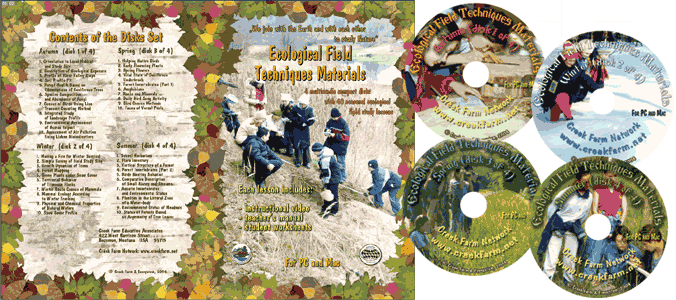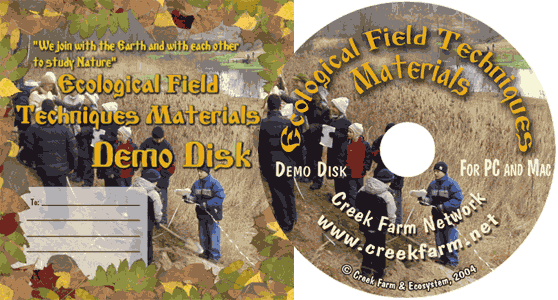|
| Our Field Ecology Center published more than
180 methodical materials for nature studies. Some of them are in English: |
|
|
|
The Study of Water Invertebrates in a Local River and Assessment of
Its Environmental State
© Alexsander S. Bogolyubov,
Daria N. Zasko, Russia, 1999
© Michael J. Brody, USA,
2003
 This manual is devoted
to the study of macrozoobenthos - invertebrates that inhabit the bottom of bodies
of water. The main idea of this lesson is to study these invertebrates in a local small
river or stream and to determine water quality based on species composition and
representation of various collected organisms. This manual is devoted
to the study of macrozoobenthos - invertebrates that inhabit the bottom of bodies
of water. The main idea of this lesson is to study these invertebrates in a local small
river or stream and to determine water quality based on species composition and
representation of various collected organisms.
This field study has instructional video
featuring real students conducting the ecological field techniques in nature. Each video
illustrates the primary instructional outcomes and the major steps in accomplishing the
task including reporting the results.
Introduction
Zoobenthos (from bentos Ц depth) all the invertebrates that inhabit the bottom of
bodies of water (or the benthic zone), aquatic vegetation (or phytal)
as well as other substrates including those associated with hydroengineering
facilities.
The largest benthic specimens, with a body size of more than 2 mm, are called macrozoobenthos.
The following make up the category Macrozoobenthos: worms (planaria, oligochaetae,
leeches, round worms), mollusks (gastropoda and bivalves), Crustacea
class (amphipods, isopods, decapods, etc), arachnids, and insects (midges,
geleides, May-flies, stoneflies, caddis-flies, dragon flies and so on), etc.
Many of these living organisms also dwell in the water column (pelagic zone);
they include insects, Crustacea class (mysidacea, pallacea and others), spiders,
etc.
The lives of many other bottom organisms can also be connected with the water surface,
i.e. surface film (neistalic zone).
According to its functions, macrozoobenthos represents an important part of the heterotrophic
component of water systems. Macrozoobenthic organisms are particularly involved in the
processes of converting outside energy sources (plant and detritus material) into
available energy within the system.
Changes in the species structure of biocoenosis correlating with level of
water pollution have attracted hydrobiologistsТ attention for a long time. The
high stenobionicty (demands for certain environmental conditions) of a number of
species, formation of complex multi-component systems, attachment to certain types of
substrates, relative low motility (mobility) (in comparison with fast-spreading
pollutants) allow the use of zoobenthic organisms as indicators for determining human (anthropogeneous)
impact on aqueous ecosystems.
Different methods of water quality assessment, numerous articles and publications as
well as the data of long-term observations within the hydrological network of
environmental monitoring prove the importance of benthos for determining characteristics
of water quality. Because macrozoobenthos specimens are relatively large, their detection
and determination by young ecologists (environmentalists) is made easier.
Procedure for studying macrozoobenthos
General information
The study of macrozoobenthos and fulfillment of this educational task can best be
carried out at a nearby small river or stream with a slow current.
An ideal location for studying zoobenthos is a river valley, which is not too wide
(5-20 meters wide) and not too deep (up to 1.5 meters deep), or a relatively flat section
of a mountain river with a slow flow and well-developed high aqueous vegetation. A fast
mountain river with a coarse-silted bottom and absence of high aqueous vegetation, or
reservoirs with stagnant water are less suitable for this research.
In order to make sample collection easier it is recommended to choose a shallow river
section to collect samples at different places by walking in the river (not from a boat or
a bridge). Periods of sample collections are limited by the seasonal life cycles of
benthic organisms. These life cycles occur year round and are not limited to the period
from July to November.
Sample collection
Selection of sites for sampling in the river is the starting point of all
hydrobiological studies.
For the purposes of this task, an average river section should be chosen. The
best area will have favorable oxygen conditions, such as shade and high water vegetation.
It is not advisable to collect samples at where ground water discharges, at stagnant
sections, or other unfavorable river sites. These areas will not give a true indication of
the entire river system.
Samples collected from the abyssal part of a river are also not suitable,
because they may not characterize water quality but rather, the pollution of bottom
sedimentation, which can greatly differ in chemical composition from the water in the
river as whole.
For these studies, mountain and piedmont rivers with rocky-pebbled bottoms are best. If
these conditions are unattainable, (or for river valleys) samples should be collected
from...
This was only the first page from the manual and its full version you can see in the
Ecological Field Studies Techniques Video 4CD Set:
It is possible to purchase the complete set of 40 seasonal Ecological Field
Studies Techniques Video (in mpg format) in an attractive 4 compact disk set.
These compact disks are compatible with Mac and PC computers.
The videos are suitable for individual student or whole class instruction. To purchase the complete 4CD set
write to ecosystema1994@yandex.ru in a free form.

Ecological Field Studies Demo Disk:
We also have a free and interesting demonstration disk that explains our ecological field studies approach.
The demo disk has short excerpts from all the seasonal field study videos as well as sample text from all the teacher manuals.
The disk has an entertaining automatic walk through which describes the field study approach and explains how field studies meet education standards.
You can also download the Demo Disc from ecosystema.ru/eng/eftm/CD_Demo.iso.
This is a virtual hybrid (for PC and Mac computers) CD-ROM image (one 563 Mb file "CD_Demo.iso").
You can write this image to the CD and use it in your computer in ordinary way.
You also can use emulator software of virtual CD-ROM drive to play the disk directly from your hard disk.

|







